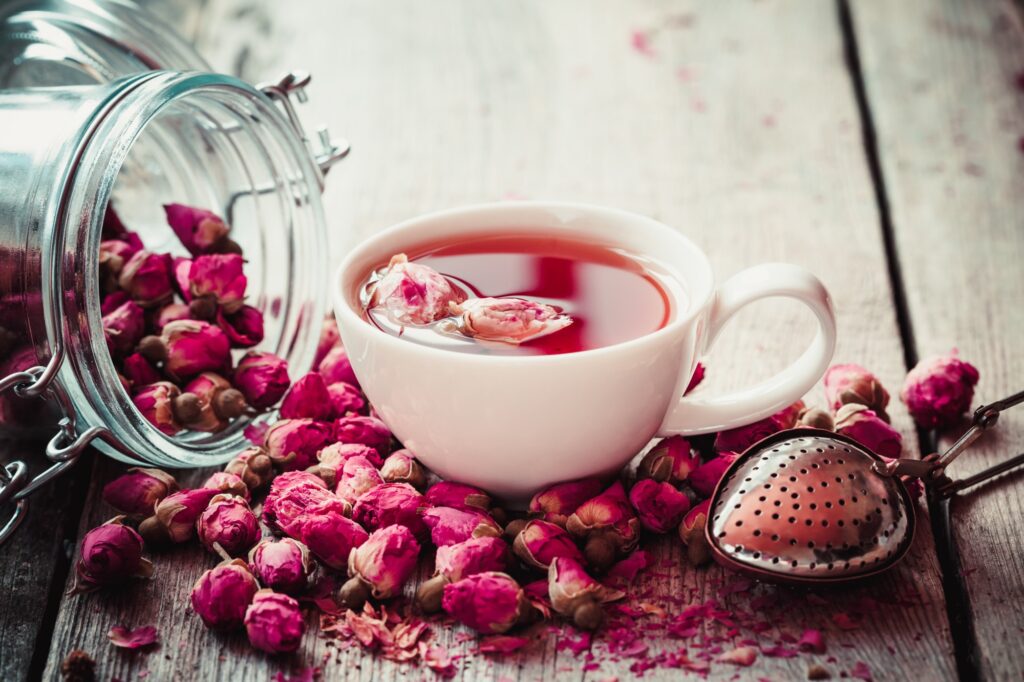
Indulge in the delicate and soothing flavors of rose tea with our step-by-step guide to crafting the perfect cup at home.
Health benefits of rose tea
Rose tea not only delights the senses but also offers numerous health benefits. The therapeutic properties of roses have been recognized for centuries, and drinking rose tea allows you to enjoy these benefits in a delicious and refreshing way.
One of the primary health benefits of rose tea is its ability to promote relaxation. The gentle aroma and flavors of roses have a calming effect on the mind and body, making it the perfect beverage to help reduce stress and anxiety. Additionally, rose tea is often used as a natural remedy for menstrual cramps and mood swings, thanks to its soothing properties.
Rose tea is also known to aid digestion. It can help relieve digestive issues such as bloating, indigestion, and constipation. The natural compounds found in roses have a gentle laxative effect, promoting healthy bowel movements and improving overall gut health.
Moreover, rose tea is rich in antioxidants, which play a crucial role in protecting the body against free radicals and reducing inflammation. The antioxidants present in rose tea can help boost the immune system, improve skin health, and even support heart health.
Incorporating rose tea into your daily routine can provide a myriad of health benefits, making it a delightful and nourishing beverage to enjoy.
Selecting the right rose petals
When it comes to making rose tea, selecting the right rose petals is essential to achieve the perfect balance of flavors. Not all roses are suitable for brewing tea, so it’s crucial to choose petals that are specifically grown for consumption.
Look for organically grown roses that are free from pesticides and other harmful chemicals. Organic roses not only ensure a safer tea but also guarantee a more natural and authentic taste.
In terms of variety, the most commonly used roses for making tea are Rosa damascena and Rosa centifolia. These rose varieties are renowned for their fragrant and flavorful petals, making them ideal for brewing tea.
When selecting rose petals, opt for fresh ones that are vibrant in color and have a strong aroma. Avoid using wilted or discolored petals, as they may not provide the desired flavors and aromas.
To ensure a sustainable approach, consider growing your own roses. This way, you have full control over the cultivation process, ensuring that your tea is made from the freshest and highest quality petals.
Properly selecting the right rose petals will lay the foundation for a delightful and aromatic cup of rose tea.
Preparing the tea base
Before infusing the delicate flavors of rose into your tea, it’s important to prepare the tea base. The tea base serves as the foundation onto which the rose petals are added, creating a harmonious blend of flavors.
The choice of tea base depends on personal preference and desired flavors. Black tea, green tea, and white tea are commonly used as the base for rose tea. Each type of tea imparts its own unique characteristics to the final brew.
If you prefer a robust and full-bodied cup of rose tea, opt for black tea as the base. The bold flavors of black tea provide a strong backdrop for the delicate rose petals.
For a lighter and more delicate infusion, green tea or white tea can be used. Green tea offers a slightly grassy and vegetal flavor that pairs well with the floral notes of roses. White tea, on the other hand, has a subtle and sweet flavor that allows the rose petals to shine.
To prepare the tea base, start by boiling water to the appropriate temperature for the chosen tea type. Follow the recommended steeping time and water temperature for the specific tea you’re using, as this will ensure optimal extraction of flavors.
Once the tea is brewed, strain the leaves and let the tea cool slightly before adding the rose petals. This will prevent the delicate flavors of the rose petals from being overwhelmed by the hot tea.
Infusing the delicate flavors of rose
Infusing the delicate flavors of rose into your tea requires a gentle and careful approach. The goal is to achieve a harmonious balance of flavors, where the roses enhance the tea without overpowering it.
There are various methods you can use to infuse rose petals into your tea. The most traditional method is to add the petals directly into the brewed tea. This allows the flavors of the roses to meld with the tea naturally.
To do this, simply add a handful of fresh rose petals to your cup of brewed tea. Let the petals steep for a few minutes, allowing their delicate flavors to infuse into the tea. The steeping time can be adjusted based on personal preference, but be cautious not to steep for too long, as this may result in a bitter taste.
Alternatively, you can create a homemade rose extract to infuse into your tea. This method provides a more concentrated rose flavor and allows for better control over the intensity of the taste.
To make a rose extract, start by thoroughly washing and drying a handful of fresh rose petals. Place the petals in a clean jar and cover them with a high-proof alcohol such as vodka or brandy. Seal the jar tightly and let it sit in a cool, dark place for at least two weeks, shaking it occasionally.
After the two-week period, strain the liquid to remove the rose petals, and you’ll be left with a fragrant rose extract. Add a few drops of the extract to your brewed tea, adjusting the amount based on your preference for a stronger or milder rose flavor.
Experiment with these different methods of infusing rose petals into your tea to find the one that suits your taste buds best. Remember, the key is to achieve a delicate balance of flavors that allows the roses to shine without overpowering the tea.
Brewing techniques for rose tea
Brewing rose tea requires a gentle touch to fully capture the delicate flavors and aromas of the rose petals. Follow these brewing techniques to ensure a perfect cup of rose tea every time.
- Start by boiling fresh, filtered water to the appropriate temperature for the chosen tea base. Different tea types require different water temperatures for optimal extraction of flavors. Generally, black tea should be brewed with boiling water, while green tea and white tea require slightly cooler temperatures.
- Once the water has reached the desired temperature, pour it over the tea leaves in a teapot or cup. Use approximately one teaspoon of tea leaves per cup of water, or adjust according to your taste preferences.
- Allow the tea to steep for the recommended amount of time. This can vary depending on the tea type and desired strength. As a general guideline, black tea should steep for 3-5 minutes, green tea for 2-3 minutes, and white tea for 1-2 minutes.
- After the initial steeping time, add the rose petals to the tea. Use approximately one tablespoon of rose petals per cup of tea, or adjust according to your preference. Let the tea and petals steep together for an additional 2-3 minutes to allow the flavors to meld.
- Once the desired steeping time has passed, strain the tea to remove the leaves and petals. This will prevent the tea from becoming too strong or bitter. If using a teapot, pour the tea into individual cups, ensuring an even distribution of flavors.
By following these brewing techniques, you’ll be able to extract the delicate flavors of the rose petals and create a fragrant and aromatic cup of rose tea.
Enhancing the flavor of rose tea
While rose tea is delightful on its own, there are various ways to enhance its flavor and create a more complex and indulgent experience. Here are some ingredients and flavors that pair well with rose tea:
- Honey: Add a drizzle of honey to your cup of rose tea to enhance its natural sweetness. The floral notes of the rose petals beautifully complement the rich and smooth flavors of honey. Choose a high-quality, raw honey for the best results.
- Citrus: Squeeze a few drops of lemon or orange juice into your cup of rose tea to add a refreshing and tangy twist. Citrus fruits brighten the flavors of the tea and provide a pleasant contrast to the floral notes.
- Mint: Fresh mint leaves can be added to rose tea to create a cooling and invigorating blend. The crisp and aromatic flavors of mint complement the delicate flavors of the roses, creating a refreshing and revitalizing drink.
- Spices: Experiment with adding spices such as cinnamon, cardamom, or ginger to your rose tea. These warm and aromatic spices add depth and complexity to the flavors, creating a truly indulgent and comforting beverage.
Remember to add these ingredients sparingly, as the goal is to enhance the flavors of the rose tea without overwhelming them. Start with small quantities and adjust according to your taste preferences.
Serving and enjoying rose tea
The art of serving and enjoying rose tea goes beyond just the flavors and aromas. The presentation and ambiance can greatly enhance the overall experience. Here are some tips for serving and enjoying rose tea:
- Use delicate and beautiful tea cups or glassware to showcase the vibrant colors of the tea and rose petals. Aesthetically pleasing servingware adds an extra touch of elegance to the experience.
- Serve rose tea alongside light and delicate pastries or biscuits. The subtle flavors of rose tea pair well with treats that are not overly sweet or rich. Opt for dainty treats that won’t overpower the flavors of the tea.
- Create a calm and serene environment for enjoying your rose tea. Find a cozy spot where you can relax and savor the flavors without distractions. Dim the lights, play soft instrumental music, or light a scented candle to further enhance the sensory experience.
- Take the time to fully appreciate the aroma and flavors of the tea. Close your eyes, inhale deeply, and let the delicate floral notes transport you to a place of tranquility and bliss. Sip slowly and savor each sip, allowing the flavors to unfold on your palate.
By paying attention to the details of serving and creating a serene ambiance, you’ll be able to fully immerse yourself in the experience of enjoying rose tea.
Variations and recipes with rose tea
While rose tea is delightful on its own, it can also be incorporated into various recipes and beverages to create a wide range of flavors and experiences. Here are some variations and recipes that showcase the versatility of rose tea:
- Iced Rose Tea: Brew a strong cup of rose tea and let it cool to room temperature. Pour the tea over ice and garnish with fresh rose petals or a slice of lemon. This refreshing iced tea is perfect for hot summer days.
- Rose Chai Latte: Prepare a cup of strong black tea as the base. Add a tablespoon of rose petals, a pinch of cinnamon, cardamom, and a splash of milk. Sweeten with honey to taste. This aromatic and indulgent beverage combines the flavors of rose tea with the warmth of chai spices.
- Rose Infused Cocktails: Use rose tea as a base for cocktails to create unique and floral flavors. Combine rose tea with gin, vodka, or champagne for a refreshing and sophisticated drink. Experiment with different fruit juices, herbs, and sweeteners to create your own signature rose-infused cocktail.
- Rose and Vanilla Cake: Infuse rose tea into a vanilla cake batter to create a fragrant and delicate dessert. Replace a portion of the liquid in the recipe with steeped rose tea. The subtle flavors of rose will complement the sweetness of the vanilla, resulting in a moist and aromatic cake.
These variations and recipes demonstrate the versatility of rose tea and its ability to elevate various culinary creations. Let your creativity flow and experiment with different combinations to discover your own unique rose-inspired delights.
Enjoy!
Congratulations! You’ve now mastered the art of making the perfect rose tea at home. Armed with the knowledge of selecting the finest rose petals, preparing the tea base, and infusing the delicate flavors of rose, you can now embark on a journey of sensory bliss.
Remember to choose organically grown roses for the freshest and most authentic flavors. Properly prepare the tea base to create a harmonious blend with the rose petals. Experiment with different brewing techniques and infusing methods to find your preferred balance of flavors.
Enhance the taste of rose tea with ingredients such as honey, citrus, mint, or spices. Pay attention to the presentation and ambiance when serving and enjoying your tea, creating a serene and indulgent experience.
Don’t be afraid to explore variations and recipes that incorporate rose tea into other culinary creations. Let your creativity shine and discover new and exciting ways to enjoy the delicate flavors of rose.
Now, armed with this step-by-step guide, it’s time to brew a cup of fragrant and aromatic rose tea and immerse yourself in its enchanting essence. Sit back, relax, and savor the delicate flavors as you embrace the tranquility that rose tea offers. Cheers to the perfect cup of rose tea!






